jesuscrisp
Well-known member
Since there have been a couple of threads on the topic of "I want to do this pedal but with a clean blend" and "I want to blend two circuits" and I don't want to repeat myself all the time, here is a bit about clean blends. I have zero electronics background, am a self-taught pedal nerd and won't be able to answer ALL technical questions they arise. I am more of a f*ck-around-and-figure-it-out guy who loves to keep things reasonably simple, but also loves if things are engineered nicely.
So that being said, this is how to blend...
1. Buff n Blend
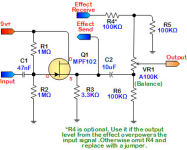

The DIY classic, the one that is always mentioned first whenever people ask. What it actually is, is a JFET buffer that splits into 2 paths into a blend pot. As pictured here, some versions use a single JFET, others do 2 parallel ones. From my experience it doesn't matter whether it's a single JFET or 2. Linear pots usually work better, ideally even using a smaller value, else you lose a bunch of volume towards the middle portion. You could theoretically also go for any other buffer you prefer, whether it's an op amp, BJT or MOSFET transistor. Regardless which version we're looking at, I personally am not a huge fan as it really is just a quick and dirty less than ideal solution that you should only resort to if you want to drop in a small footprint clean blend for whatever reason.
Why it sucks?
2. Op Amp Panning Mixer

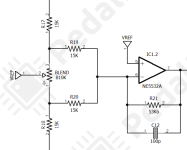
Just like the Split n Blend, this is a "panning" clean blend. It goes from completely clean to completely dirty, which depending on your application may be desirable. These snippets are taken from the PedalPCB Bootleg. As much as I like to trash JHS, this blend design is an actually smart one (mostly, NE5532 isn't a great input stage for a high-impedance buffer, there was zero need to also keep the BJT buffers of the TS and the volume is also BEFORE the blend knob).
What this one needs is a buffer, no matter if BJT, JFET, MOSFET or op amp, but using a dual IC is usually the most practical (unless your circuit has a leftover IC stage anyway for example). From the input buffer (left picture), you go with a capacitor for each path and end up at the blend control (right picture, don't forget your caps that aren't picture here!).
Why is it better?
3. "Additive" Op Amp Blend
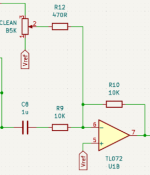
My personal favorite solution because honestly, I don't ever feel like I need less overdriven than clean signal when putting a clean blend in a circuit. This snippet is from my thread about simplifying the Gladio/Scenario SC, find it HERE.
Like the previous blend circuit, this needs a buffer to split off the clean signal and a capacitor to the clean blend knob, as well as an op amp mixing stage. What we're doing here is basically just turning up and amplifying the clean signal and mixing it with the dirty path. The other side of the pedal stays the same volume throughout, you're just adding back clean signal and thereby potentially some clarity and dynamics. It's basically what the Klon is doing, just seperated from the gain knob here and simplified. Add a master volume at the end.
Why I like it?
4. ROG Splitter-Blend
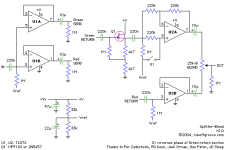
Another DIY classic, this one is more aimed at blending 2 FX loops as opposed to just a clean signal with your favorite dirt pedal that you wish had a clean blend.
IMO it is quite bloated, but if you want a tool that helps you come up with circuit combinations to blend, it's probably useful. The phase inverter might also be useful if you're building a circuit with a clean/fx loop for people to plug their pedals into.
Other than that it really is just an elaborate Split n Blend that gives you the built-in phase inversion option and also buffers both paths at the output.
5. Multi-Channel Op Amp Mixer
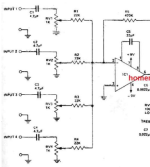
This is basically the elaborate version of the "Additive" blend, only that instead of only just giving the clean signal a volume control, you're adding one to each path, which could be 2 or more. This is a good option if you want seperate clean and dirty volume controls or you're running 2 dirt circuits in parallel that you want to control the level of individually. Each of the inputs in the picture would be the output of your respective path and after the summing up amp you can also add a master volume. This one is more for the sake of completeness really, but there's certainly use for it other than just building a 3 channel mixer.
For most guitar effects, I feel like the volume pots would be better off as 10K ones and be aware that the schematic pictured here is running off a bipolar supply, so all the ground connections would be Vref (half supply voltage) instead using a standard power supply in your circuit.
6. General Tips
There's also more elaborate but also stupid blend designs out there but I think these here cover most of the ground.
Please feel free to ask stuff and also correct any of my mistakes, preconceptions, generalizations or inaccuracies.
So that being said, this is how to blend...
1. Buff n Blend


The DIY classic, the one that is always mentioned first whenever people ask. What it actually is, is a JFET buffer that splits into 2 paths into a blend pot. As pictured here, some versions use a single JFET, others do 2 parallel ones. From my experience it doesn't matter whether it's a single JFET or 2. Linear pots usually work better, ideally even using a smaller value, else you lose a bunch of volume towards the middle portion. You could theoretically also go for any other buffer you prefer, whether it's an op amp, BJT or MOSFET transistor. Regardless which version we're looking at, I personally am not a huge fan as it really is just a quick and dirty less than ideal solution that you should only resort to if you want to drop in a small footprint clean blend for whatever reason.
Why it sucks?
- A direct clean blend will at best only reach unity volume as nothing is boosting it, hence it will be easily overpowered by whatever else you're blending it with.
- It won't work with phase-inverting circuits (right-away) as it will put your clean signal out of phase.
- You don't have a master volume so you'll always need to adjust your blend AND volume knobs.
- More volume: boost your clean path with a small clean boost circuit BUT be aware of phase issues! In case you're using a parallel circuit that doesn't flip phase you would need something like a NON-inverting op amp to boost.
- Phase-inversion: putting a boost in parallel with a phase-inverting dirt circuit can kill two birds with one stone. Basically speaking, any single-transistor boost (LPB-1, SHO, ... ) or an inverting op amp gain stage can take care of flipping phase AND getting you more volume on the clean path.
- Master volume: If the dirt circuit you're blending with is stupidly low volume itself, you can also just skip the volume control on the dirt circuit, put a boost after the blend knob and go with a volume knob at the end. The issue is with any circuit that ISN'T low volume, since the blended clean signal is only unity gain when maxed out and will be overpowered by the parallel circuit.
2. Op Amp Panning Mixer


Just like the Split n Blend, this is a "panning" clean blend. It goes from completely clean to completely dirty, which depending on your application may be desirable. These snippets are taken from the PedalPCB Bootleg. As much as I like to trash JHS, this blend design is an actually smart one (mostly, NE5532 isn't a great input stage for a high-impedance buffer, there was zero need to also keep the BJT buffers of the TS and the volume is also BEFORE the blend knob).
What this one needs is a buffer, no matter if BJT, JFET, MOSFET or op amp, but using a dual IC is usually the most practical (unless your circuit has a leftover IC stage anyway for example). From the input buffer (left picture), you go with a capacitor for each path and end up at the blend control (right picture, don't forget your caps that aren't picture here!).
Why is it better?
- The summing op amp stage will provide a volume boost to the respective side of the blend control while also actually turning the other side down, not just putting resistance in the respective signal path.
- You can give your circuit more volume by increasing the feedback resistor of the summing op amp (R21 in the picture) without needing another stage, plus also tame some high end with the feedback capacitor (C12 here).
- Very loud circuits might be hard to balance (and worst case could make the mixing stage distort), so you might want to mess with the resistor values on either side of the blend knob.
- Blending phase-inverting signals might still be an issue, same solutions apply as in the Split n Blend, although you can get away with an inverting op amp buffer or just "unity gain" transistor boost.
3. "Additive" Op Amp Blend

My personal favorite solution because honestly, I don't ever feel like I need less overdriven than clean signal when putting a clean blend in a circuit. This snippet is from my thread about simplifying the Gladio/Scenario SC, find it HERE.
Like the previous blend circuit, this needs a buffer to split off the clean signal and a capacitor to the clean blend knob, as well as an op amp mixing stage. What we're doing here is basically just turning up and amplifying the clean signal and mixing it with the dirty path. The other side of the pedal stays the same volume throughout, you're just adding back clean signal and thereby potentially some clarity and dynamics. It's basically what the Klon is doing, just seperated from the gain knob here and simplified. Add a master volume at the end.
Why I like it?
- Very simple, very effective, probably the best choice for most things that aren't EXTREME fuzz and distortions like Muffs and HM-2s. Put this on your favourite low to medium gain overdrive and get back some dynamics and sparkle or crank it up!
- It's pretty low parts count all things considered.
- You can also use it to amplify low volume dirt circuits (adjust R9/R10).
- Yet again, it doesn't help if the circuit in parallel is out-of phase.
4. ROG Splitter-Blend

Another DIY classic, this one is more aimed at blending 2 FX loops as opposed to just a clean signal with your favorite dirt pedal that you wish had a clean blend.
IMO it is quite bloated, but if you want a tool that helps you come up with circuit combinations to blend, it's probably useful. The phase inverter might also be useful if you're building a circuit with a clean/fx loop for people to plug their pedals into.
Other than that it really is just an elaborate Split n Blend that gives you the built-in phase inversion option and also buffers both paths at the output.
5. Multi-Channel Op Amp Mixer

This is basically the elaborate version of the "Additive" blend, only that instead of only just giving the clean signal a volume control, you're adding one to each path, which could be 2 or more. This is a good option if you want seperate clean and dirty volume controls or you're running 2 dirt circuits in parallel that you want to control the level of individually. Each of the inputs in the picture would be the output of your respective path and after the summing up amp you can also add a master volume. This one is more for the sake of completeness really, but there's certainly use for it other than just building a 3 channel mixer.
For most guitar effects, I feel like the volume pots would be better off as 10K ones and be aware that the schematic pictured here is running off a bipolar supply, so all the ground connections would be Vref (half supply voltage) instead using a standard power supply in your circuit.
6. General Tips
- Be aware of phase inversions! As a general rule, inverting op amp stages and transistor stages where the signal goes through the Drain/Collector flip your signal. Non-inverting op amp stages and transistor "buffers" where the signal goes through the Emitter/Source do not flip phase. If there's an even number of phase inversions, it's NOT flipped, if it's an uneven number it IS flipped.
- As mentioned, a single-transistor boost or spare IC stage can help to flip the phase back if needed.
- If the circuit you want to add a clean blend to already has an input buffer, by all means just use that input buffer for signal splitting or replace it, there's no need to go buffer into buffer (like the Bootleg/Moonshine).
- JFETs and JFET-input op amps are generally preferred for signal splits/input buffers due to the high input impedance they can have, but there's nothing wrong with using BJTs or BJT-input op amps either.
- If you're designing a pedal from scratch, DON'T just blindly go for the Split n Blend circuit.
- Clean-blending vintage-style fuzzes will require you to make adjustments to the circuit or add a pickup simulator transformer AFTER the buffer in the path of the fuzz. Else you have the effect of a buffer in front of a fuzz pedal, which generally is a no-no.
There's also more elaborate but also stupid blend designs out there but I think these here cover most of the ground.
Please feel free to ask stuff and also correct any of my mistakes, preconceptions, generalizations or inaccuracies.

